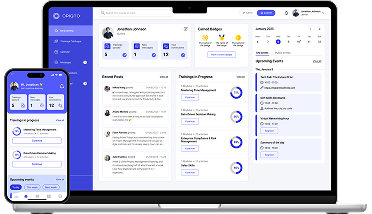As eLearning gains momentum in the increasingly digital world, professionals turn to online classrooms for themselves and their employees. When examining online learning options, two fundamental learning styles often crop up: synchronous and asynchronous learning.
In essence, synchronous learning is a classroom-style experience with everyone in attendance simultaneously learning the same lesson in the same format. On the other hand, asynchronous learning lets individuals take the class on their own schedule and promotes self-paced learning activities. The learning objectives remain the same in both cases, but the learning process differs.
When building a learning management system, it’s essential to understand the benefits of both asynchronous and synchronous learning, as a blend of the two is common in current online courses. Here’s a look at some of the benefits of both asynchronous and synchronous learning.
Introduction: Asynchronous Learning
It may seem asynchronous learning is unfamiliar, but it’s closer to home than you realize. Asynchronous learning activities are perfect for busy schedules. By definition, asynchronous means not simultaneous or concurrent. Asynchronous learning then means that learning can take place without concurrent instruction. Asynchronous learning promotes a learner-centred approach, reduces training costs and provides access to a wide range of training material.
Asynchronous learning can increase productivity through bite-size modules
Because learners can access the LMS from computers, tablets, or even mobile devices, professionals can pull up the asynchronous course and take one or two quick lessons while on the go or between other pressing activities.
Asynchronous classes let you learn at your own pace
Not everyone can be an active participant in educational activities for an extended period. While some can easily sit through an extended lecture or online course, others find it much easier to retain information when participating on their own schedule. Asynchronous learners benefit when they get to decide when and how their learning is achieved.
Asynchronous self-paced learning
Asynchronous learning is learning that is created and made available for consumption later on for self-paced learning. For example, classes, microlearning, webinars and podcasts can be recorded and saved for self-paced learning. Course material is accessible via the internet, and people can learn on their own time within a specific timeframe. Asynchronous learning is ideal for accelerating the onboarding process.
Asynchronous activity types
Asynchronous platforms bring training to learners no matter where they are located. They typically include games and quizzes, assessments, long-form reading, viewing video lectures and presentations, reading or writing assignments to engaging discussion boards/forums. An asynchronous learning system can tap into the benefits of microlearning with small, digestible pieces of information.
Introduction: Synchronous Learning
Synchronous learning offers live virtual classes with your instructor and classmates and instructor-led discussions. Students can lead discussions themselves or give presentations to the rest of the class. Students can also work in small groups in a social learning environment. Synchronous learning delivers a connected and engaged style of learning. Students can make meaningful connections, make relationships, and reach out to their instructors and classmates.
Synchronous learning keeps learners engaged. One of the primary benefits of synchronous learning is it prevents learners from feeling isolated. For many, learning on their own feels like looking into a void, and the idea of doing independent study bores them. With synchronous activities, they get to engage with other learners in the same environment and discuss the material in real-time with others. There’s no waiting for answers to questions, either, keeping them constantly engaged with the content.
Synchronous classes do the scheduling for you.
Some professionals might prefer a regularly scheduled course to plan their day around without worrying about squeezing in time wherever they can find it. Synchronous learning does all the scheduling for you, so busy professionals don’t need to worry about setting aside sporadic moments in the day to take their eLearning course. With synchronous classes, learners have a set time to be online for the lesson.
Synchronous sessions suit hands-on learning
Synchronous learning is ideally suited for training where instruction is best done hands-on. Subjects like first aid require an instructor to look over your work in real-time to correct mistakes since it has a significant physical component. While some of these subjects can include asynchronous parts, such as basic reading materials that can be done anywhere, other aspects require synchronous activities to grasp the lesson fully.
Synchronous engagement and interaction in a live environment.
Synchronous learning often has the edge over asynchronous learning regarding peer interaction and building relationships. Instructors, trainers and learners can use live video calls and streamed classrooms to interact with the training and tutor. Learners can be divided into subgroups to participate in peer-to-peer learning. This can assist in retention, boost motivation, and make students more active participants outside of just taking the online courses.
Conclusion
Asynchronous and Synchronous combined learning offers organizations the ability to deliver self-paced learning and real-time learning and interaction with instructors and peers. Learning management systems are designed to deliver asynchronous and synchronous learning techniques.
A blend of asynchronous and synchronous learning allows an LMS to suit individual learning styles. Contact Opigno today for a demo to see how asynchronous and synchronous learning can suit your business needs.
Author: Adam Kennedy-Ripon
Design: Simon Contreras
